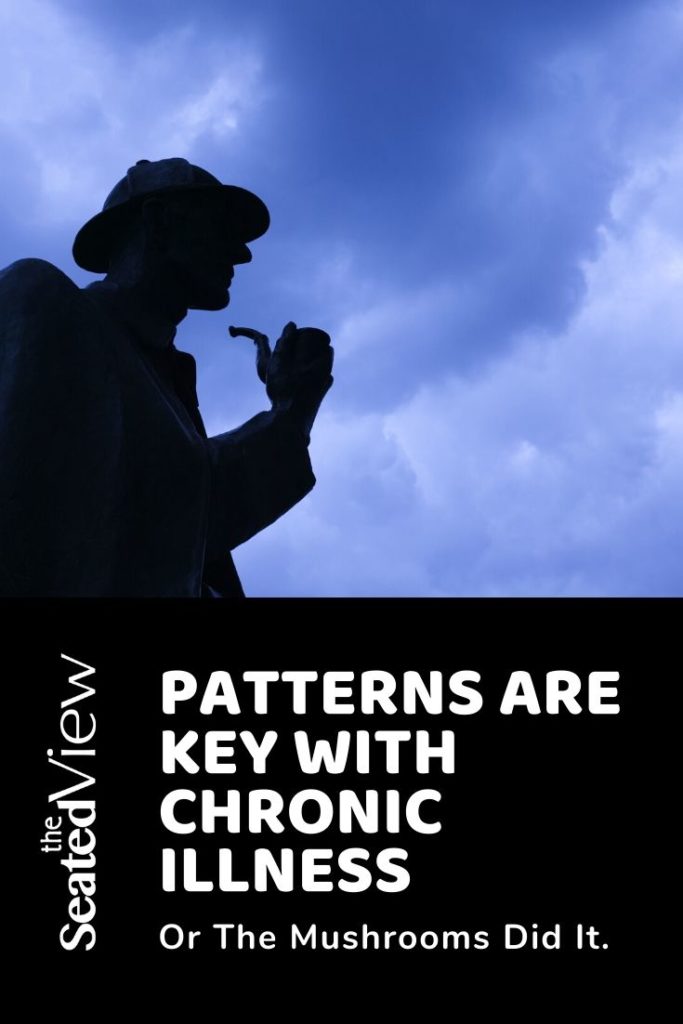Patterns are Key with Chronic Illness Or The Mushrooms Did It

Updated April 14, 2021
When you live with an unpredictable chronic illness such as rheumatoid arthritis (RA), fibromyalgia, migraines, or any of a multitude of conditions that play havoc with you every day, figuring out triggers — things that make your symptoms worse — can be an important part of improving your life.
Also feel more in control. That’s important and not just for those of us who are control freaks.
A fun(gi) sidetrack
I had an allergic reaction last week. Nothing life-threatening, but hive-y, extremely itchy, and whenever I scratched, red welts would appear. I haven’t had one of those in years — by now, I know enough to not eat too much of the foods that normally make this happen.
I talked to The Boy about it, saying I couldn’t figure out what had caused this, after all, I’d done or eaten nothing unusual. He reminded me we’d been to a restaurant the night before. Where I had ordered what I always have.
And then the lightbulb went off.
He’s had potato and mushroom perogies and shared one with me. At the end of the meal, I felt a bit of a scratch in my throat and if you have allergies, you know the one. The “something just pushed your histamine button, nothing to worry about, I’m just going to irritate you” kind of scratch. I dismissed it, because I often have weird allergic symptoms that have no explanation, especially after my biologic injection. Twenty-four hours later, in the throes of a major itch fest, I then remembered a similar itch after eating a quite wonderful mushroom-based sauce a few months back.
Then I looked it up. And discovered that if you’re allergic to mould — which I am — you may also be allergic to mushrooms.
Bingo! Also: damn. After a lifetime of loathing the things, I’ve just discovered quite the liking for mushrooms. Which can also be really useful in winter.

It’s all about patterns
So much of living with chronic illness is about being aware of patterns. I’m an old fart, so I grew up in a time before tracking apps and had to learn to track things myself. By now, after decades of paying attention to my body, the pattern detection radar is pretty much second nature. That is, it might take a few instances of cause-and-effect, but it usually makes the connections pretty quickly.
Especially when I remember potential contributing factors. Such as mushrooms.
At its core, research is pattern recognition, but with statistics. You don’t have to bother with the math, but applying the same principles to your everyday life can help identify the things that make you hurt (or itch), which allows you to make better plans.
More than that, honing your pattern recognition skills can help you with both ends (if you will) of chronic illness. To find out what makes things worse, sure, but paying attention to patterns can also help you figure out what might help your symptoms get better.
For me, knowing that certain kinds of pain react better to heat than ice, whereas others want ice, not heat, help me get on top of the issue and how it impacts my life a little faster. Knowing that a long drive means I need several days to recover is important, but so is knowing that taking pain meds in a preventative way, such as before the drive, reduces my crash time.
And so on.
How to turn on your pattern radar
The following can help you turn on your own pattern radar:
Pay attention. When you have a symptom, study it. What does it feel like, when did it happen, how does it affect you? Smaller symptoms might be ignored with a shrug, more medium symptoms of the irritating kind should probably be noted, and the big one might even require your doctor.
(With the usual disclaimer that I am not a medical professional, just someone who’s lived with chronic illness for a bunch of years)
Think about it. It is not enough to just study the symptom and make sure you understand it, you also want to put it in context. Have you done something unusual or different than your normal routine? Can you pinpoint a trigger fairly easily or isn’t it obvious? Do you remember having had something like this before, more recently, or maybe in the past?
Make a note. If your chronic illness makes your brain foggy, you may want to make a note of the symptom and its context. You can use an old-fashioned notebook, a note app on your phone, and this is also when tracking apps can come in handy.
One comment about that, though — have you noticed that people who drive for a living no longer seem to know how to get places without a GPS? If you don’t have to remember how to get to that particular side street in rush hour traffic, you… don’t. The same goes for tracking apps. Your brain is probably more reliable in the long run than an app. After a while, you no longer need to make specific notice of something, but can leave the analysis to run in the back of your brain, much like a computer.
Give yourself credit. Positive reinforcement works, both for puppies and people. When you have successfully identified a trigger through noticing a pattern, pat yourself on the back. Maybe even tell a friend about it. It’ll make you feel proud of yourself (and more in control), so your mind will want to do it again.
Do you already have a pattern radar? How do you use it?
Tag: allergies, chronic illness, control, cross allergy, illness, mould, mushrooms, rheumatoid arthritis, symptoms, triggers
2 Comments
Read More
Discover what else I've been writing about...
















Sheryl tells me my patterns. In fact just today she said I have a pattern of leaving dishes in the sink, not tkaing trash out, forgetting to clean up the garage etc. Notice a pattern?
New to this web. I’m almost 60 and have had juvenile rheumatoid arthritis since 9. Lots of deformed joints, but still walking. My new issue is my spine. Especially the middle back now. Since the new laws they took me off pain meds and didn’t replace with anything. Looking forward to ideas